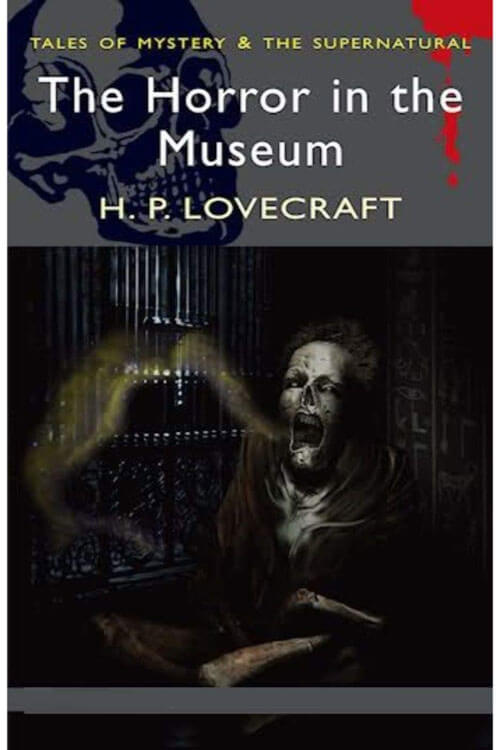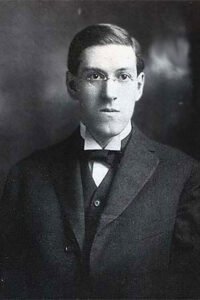
The Horror in the Museum
As Jones stood hesitating, the speaker returned to his desk and took up the photograph he had laid face down without showing. Now, he extended it with a curious look. Jones took it and glanced at it in an almost mechanical way. After a moment, the visitor’s glance became sharper and more absorbed, for the utterly satanic force of the object depicted had a nearly hypnotic effect. Indeed, Rogers had outdone himself in modelling the eldritch nightmare the camera had caught. The thing was a sheer, infernal genius, and Jones wondered how the public would react when it was placed on exhibition. So hideous a thing had no right to exist—probably the mere contemplation of it, after it was done, had completed the unhinging of its maker’s mind and led him to worship it with brutal sacrifices. Only a stout sanity could resist the insidious suggestion that the blasphemy was—or had once been—some morbid and exotic form of actual life.
The thing in the picture squatted or was balanced on what appeared to be a clever reproduction of the monstrously carved throne in the other curious photograph. To describe it with any ordinary vocabulary would be impossible, for nothing roughly corresponding to it has ever come within the imagination of sane mankind. It represented something meant perhaps to be roughly connected with the vertebrates of this planet—though one could not be too sure of that. Its bulk was cyclopean and even squatted. It towered to almost twice the height of Orabona, who was shown beside it. Looking sharply, one might trace its approximations toward the bodily features of the higher vertebrates.
Read or download Book
H. P. Lovecraft
Howard Phillips Lovecraft (August 20, 1890 – March 15, 1937) was an American writer of weird, science, fantasy, and horror fiction. He is best known for his creation of the Cthulhu Mythos.
Born in Providence, Rhode Island, Lovecraft spent most of his life in New England. After his father’s institutionalization in 1893, he lived affluently until his family’s wealth dissipated after the death of his grandfather. Lovecraft then lived with his mother, in reduced financial security, until her institutionalization in 1919. He began to write essays for the United Amateur Press Association, and in 1913, wrote a critical letter to a pulp magazine that ultimately led to his involvement in pulp fiction. He became active in the speculative fiction community and was published in several pulp magazines. Lovecraft moved to New York City, marrying Sonia Greene in 1924, and later became the centre of a wider group of authors known as the “Lovecraft Circle”. They introduced him to Weird Tales, which would become his most prominent publisher. Lovecraft’s time in New York took a toll on his mental state and financial conditions. He returned to Providence in 1926 and produced some of his most famous works, including The Call of Cthulhu, At the Mountains of Madness, The Shadow over Innsmouth, and The Shadow Out of Time. He would remain active as a writer for 11 years until his death from intestinal cancer at the age of 46.
Lovecraft’s literary corpus is based on the idea of cosmicism, which was simultaneously his philosophy and the central theme of his fiction. Cosmicism posits that humanity is an insignificant part of the cosmos and could be swept away at any moment. He incorporated fantasy and science fiction elements into his stories, representing the perceived fragility of anthropocentrism. This was tied to his ambivalent views on knowledge. His works were primarily set in a fictionalized version of New England. Civilizational decline also plays a significant role in his works, as he believed that the West was in decline during his lifetime. Lovecraft’s early political views were conservative and traditionalist; additionally, he held several racist opinions for much of his adult life. Following the Great Depression, Lovecraft’s political views became more socialist while remaining elitist and aristocratic.
Throughout his adult life, Lovecraft could never support himself from his earnings as an author and editor. He was virtually unknown during his lifetime and was almost exclusively published in pulp magazines before his death. A scholarly revival of Lovecraft’s work began in the 1970s, and he is now regarded as one of the most significant 20th-century authors of supernatural horror fiction. Many direct adaptations and spiritual successors followed. Works inspired by Lovecraft, adaptations or original works, began to form the basis of the Cthulhu Mythos, which utilizes Lovecraft’s characters, setting, and themes.
Earliest recognition
Few of Lovecraft and Susie’s activities were recorded between late 1908 and 1913. Lovecraft described the steady continuation of their financial decline, highlighted by his uncle’s failed business, which cost Susie a large portion of their already dwindling wealth. One of Susie’s friends, Clara Hess, recalled a visit during which Susie spoke continuously about Lovecraft being “so hideous that he hid from everyone and did not like to walk upon the streets where people could gaze on him.” Despite Hess’ protests to the contrary, Susie maintained this stance. For his part, Lovecraft said he found his mother to be “a positive marvel of consideration”. A next-door neighbour later pointed out that what others in the neighbourhood often assumed were loud, nocturnal quarrels between mother and son were recitations of William Shakespeare. This activity seemed to delight the mother and son.
During this period, Lovecraft revived his earlier scientific periodicals. He endeavoured to commit himself to studying organic chemistry, and Susie bought the expensive glass chemistry assemblage he wanted. Lovecraft found his studies were hampered by the mathematics involved, which he found boring and would cause headaches that would incapacitate him for the remainder of the day. Lovecraft’s first non-self-published poem appeared in a local newspaper in 1912. Called Providence in 2000 A.D., it envisioned a future where Americans of English descent were displaced by Irish, Italian, Portuguese, and Jewish immigrants. In this period, he also wrote racist poetry, including “New-England Fallen” and “On the Creation of Niggers”, but there is no indication that either was published during his lifetime.
In 1911, Lovecraft’s letters to editors began appearing in pulp and weird-fiction magazines, most notably Argosy. A 1913 letter critical of Fred Jackson, one of Argosy’s more prominent writers, started Lovecraft down a path that would define the remainder of his career as a writer. In the following letters, Lovecraft described Jackson’s stories as being “trivial, effeminate, and, in places, coarse”. Continuing, Lovecraft argued that Jackson’s characters exhibit the “delicate passions and emotions proper to negroes and anthropoid apes.” This sparked a nearly year-long feud in the magazine’s letters section between the two writers and their respective supporters. Lovecraft’s most prominent opponent was John Russell, who often replied in verse and to whom Lovecraft felt compelled to respond because he respected Russell’s writing skills. The most immediate effect of this feud was the recognition garnered from Edward F. Daas, then head editor of the United Amateur Press Association (UAPA). Daas invited Russell and Lovecraft to join the organization, and both accepted Lovecraft in April 1914.






